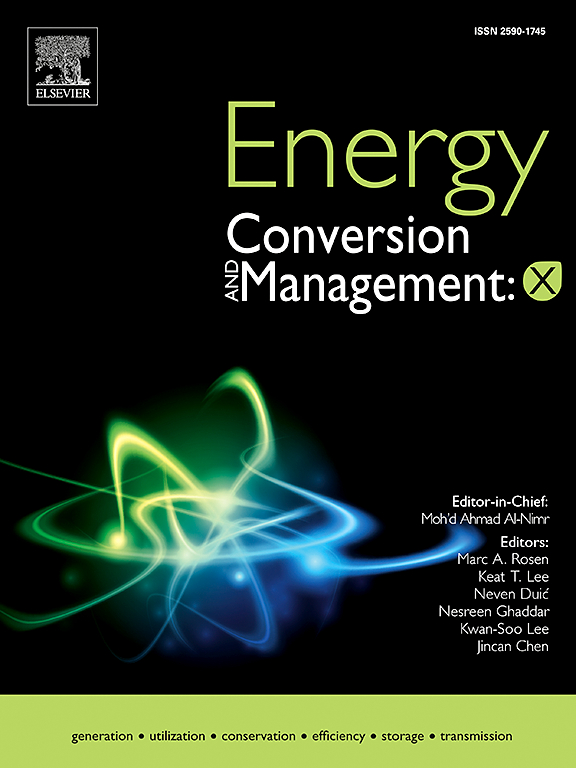Synergistic heliostat field design with intensity and homogenization matching MW-scale solar-driven dry reforming of methane
IF 10.9
1区 工程技术
Q1 ENERGY & FUELS
引用次数: 0
Abstract
Escalating atmospheric greenhouse gas concentrations and rising global energy demands have posed significant challenges to global sustainability. Solar driven dry reforming of methane assisted by carbon dioxide emerges as a promising technology for simultaneously mitigating greenhouse gas emissions and supplying low-carbon syngas. However, current solar-driven dry reforming of methane systems are mainly based on parabolic dish concentrators with solar power limited to tens of kilowatts. Here, a novel synergistic heliostat field design with intensity and homogenization matching MW-scale solar-driven dry reforming of methane is proposed. An optical-thermal-chemical model is developed for system performance evaluation by combining Monte Carlo ray tracing, the Finite Volume Method, and an Artificial neural network. Multi-objective optimization using Non-dominated Sorting Genetic Algorithm-II is further employed to balance methane conversion rate and system efficiency. High-efficiency solar concentration is achieved by optimizing heliostat field parameters and refining the aiming strategies to ensure the homogenization of solar flux among the sub-reactors. Compared to conventional heliostat field layout, the system solar-to-fuel efficiency is enhanced by 49.68 % with heliostat field land area reduced by 58.58 %. This work pioneers heliostat field design for MW-scale solar-driven dry reforming of methane, and paves the way for scalable industrial applications of solar-driven dry reforming of methane technologies.
协同定日镜场设计,强度和均质性与兆瓦级太阳能驱动甲烷干重整相匹配
不断上升的大气温室气体浓度和不断上升的全球能源需求对全球可持续性构成了重大挑战。在二氧化碳的帮助下,太阳能驱动的甲烷干式重整成为一项有前途的技术,可以同时减少温室气体排放和提供低碳合成气。然而,目前太阳能驱动的甲烷干式重整系统主要是基于抛物面碟式聚光器,太阳能功率限制在几十千瓦。本文提出了一种新的协同定日镜场设计,其强度和均质性与兆瓦级太阳能驱动甲烷干重整相匹配。将蒙特卡罗射线追踪、有限体积法和人工神经网络相结合,建立了系统性能评价的光-热-化学模型。采用非支配排序遗传算法- ii进行多目标优化,平衡甲烷转化率和系统效率。通过优化定日镜场参数和优化瞄准策略,保证子反应器间太阳通量的均匀性,实现了高效的太阳集中。与传统定日镜场布局相比,系统太阳能-燃油效率提高了49.68%,定日镜场占地面积减少了58.58%。这项工作开创了兆瓦级太阳能驱动甲烷干式重整定日镜现场设计的先河,为太阳能驱动甲烷干式重整技术的大规模工业应用铺平了道路。
本文章由计算机程序翻译,如有差异,请以英文原文为准。
求助全文
约1分钟内获得全文
求助全文
来源期刊

Energy Conversion and Management
工程技术-力学
CiteScore
19.00
自引率
11.50%
发文量
1304
审稿时长
17 days
期刊介绍:
The journal Energy Conversion and Management provides a forum for publishing original contributions and comprehensive technical review articles of interdisciplinary and original research on all important energy topics.
The topics considered include energy generation, utilization, conversion, storage, transmission, conservation, management and sustainability. These topics typically involve various types of energy such as mechanical, thermal, nuclear, chemical, electromagnetic, magnetic and electric. These energy types cover all known energy resources, including renewable resources (e.g., solar, bio, hydro, wind, geothermal and ocean energy), fossil fuels and nuclear resources.
 求助内容:
求助内容: 应助结果提醒方式:
应助结果提醒方式:


